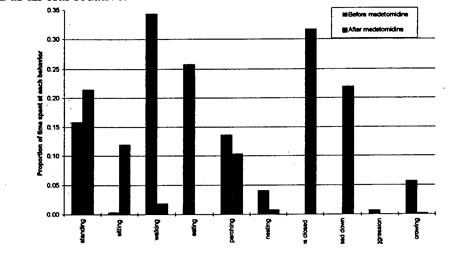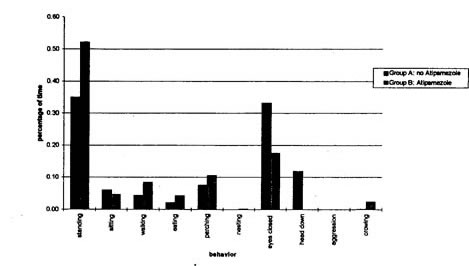Abstract
The purposes of this study were to investigate medetomidine as an oral sedative in Galliformes, to determine an effective dose range, and to determine if the effects of this alpha-2 agonist were reversible.
Six male and six female 9-mo-old domestic chickens (Gallus gallus) were used in this study with the males housed separately from the females. An ethogram, to document the effects of sedation, was developed prior to the onset of the study. Behaviors that were common to both sexes included standing, sitting, walking, perching, eating, eyes closed, and head down. Male behaviors also included aggression and crowing, while female behaviors included nesting.
The males and females were observed at 2-min intervals for 30 min at the end of which each animal was hand caught and the males were given 0.6 mg medetomidine (0.19–0.2 mg/kg) (Domitor, 1.0 mg/ml, Pfizer Animal Health, Exton, PA, USA) and the females were given 0.4 mg medetomidine (0.21–0.31 mg/kg) PO via a 1-ml syringe (Becton-Dickinson & Co., Franklin Lakes, NJ, USA). After administration of the medetomidine the birds were returned to their enclosures and behaviors recorded for an additional 45 min. The animals were then divided into two groups. Group A (three males and three females) received IV atipamezole (Antisedan, 5.0 mg/ml, Pfizer Animal Health) (3 mg and 2 mg, respectively), in a wing vein. Group B (three males and three females) were not reversed and were bled for plasma biochemical analysis. Behaviors were recorded for an additional 2.5 h. Data for the two groups were compared.
The results of time spent at each behavior before and after medetomidine are presented in Figure 1. The initial effects of the medetomidine were seen within 4 min, the average time for sedation was 6.2 min, and all animals were fully sedated by 10 min. Subjectively, after treatment, all animals had decreased activity, were minimally rousable, and were easy to catch and manually restrain. As evident in Figure 1, walking and eating decreased substantially after the medetomidine was given, whereas eyes closed and head down behaviors increased. Before the medetomidine was administered, the males vocalized an average of 5.6 times in 2 min and the females vocalized constantly. Ten minutes after the medetomidine, there were no vocalizations by either sex.
Figure 1. Behaviors of chickens (Gallus gallus) before and after the administration of medetomidine

Adverse effects of the medetomidine included one male and one female which were tachypneic at 12 min (respiratory rates approximately 60 bpm). The tachypnea resolved without intervention between 24 and 26 min. The plasma biochemistry results were within normal limits for the species.
After atipamezole was given, initial reversal effects were observed within 30 sec. Figure 2 depicts the behaviors of both groups. This figure demonstrates that group A (animals that received atipamezole IV) spent less time with their eyes closed and heads down. Subjectively, they were also more alert, moved more, and were more easily rousable than group B. Animals in group B remained stationary and were minimally rousable. Approximately 50 min after the administration of the atipamezole, the animals in group A appeared to resedate even though they remained more easily rousable than those animals in group B. There were no adverse effects noted of IV atipamezole treatment and both reversed and non-reversed birds were normal approximately 2.5 h after the administration of the medetomidine.
Figure 2. Behaviors comparing groups A and B

In conclusion, medetomidine (0.25–0.34 mg/kg PO) appears to be a good sedative for chickens when administered orally into the crop in fasted animals. The induced sedation was reversible with atipamezole (1.3–1.6 mg/kg IV). More research is needed in order to determine if medetomidine can be used effectively in food as an oral sedative.